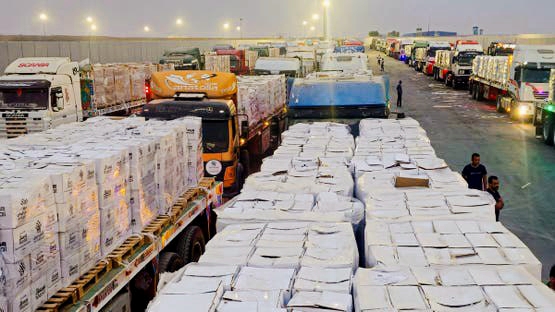This morning, Sunday, the operations for entering humanitarian aid into the Gaza Strip via the Rafah land crossing resumed, as part of the sixteenth convoy being sent in coordination between the Egyptian and Israeli authorities, under American sponsorship, amid the ongoing deterioration of the humanitarian situation in the besieged sector.
Today, 50 trucks loaded with various humanitarian and relief supplies crossed, prepared by the Egyptian Red Crescent in North Sinai.
The trucks entered from the Egyptian side through the Rafah crossing gate heading to the Kerem Shalom crossing, where they were inspected by the Israeli authorities before being allowed to cross into Gaza.
This resumption comes after a two-day halt during the Friday and Saturday holidays, and the new agreement between Egypt and Israel, with support from the United States, includes sending aid trucks from Rafah to Kerem Shalom, so that the shipments are inspected inside the Israeli crossing and then later transported to the sector via the Kerem Shalom and Zikim crossings.
Since July 27, 2331 aid trucks have entered the Gaza Strip through the Rafah crossing, carrying more than 15,000 tons of humanitarian and relief supplies, amid the worsening humanitarian crisis resulting from the ongoing war for nearly 22 months.
On the ground, 40 Palestinians were reported killed on Saturday, including children, most of them while waiting to receive aid, due to gunfire from the Israeli army, according to the civil defense and medical sources in Gaza.
These massacres coincide with an escalation of military operations in the Al-Zeitoun neighborhood north of Gaza City, where the Israeli army announced on Friday the start of "ground operations" in the area.
An Israeli military statement indicated that its forces "are working to uncover explosive devices and destroy military infrastructure above and below ground," as part of a plan announced by the Israeli security council in early August to take full control of Gaza City.
In contrast, Hamas confirmed in a statement on Saturday that "Israeli warplanes and artillery, in addition to explosive drones, have been systematically destroying the Al-Zeitoun neighborhood for a week," noting that the attacks target the eastern and southern neighborhoods of Gaza City, in what it described as a "comprehensive genocide aimed at destroying all means of life in the sector."
Amid this military escalation, the Israeli army announced that starting Sunday, it would begin providing tents and shelter equipment for the residents of the sector, as part of what it described as "preparations to transfer civilians from combat areas to southern Gaza."
These materials will be transported through the Kerem Shalom crossing after undergoing thorough inspection, in cooperation with the United Nations and international relief organizations.
Meanwhile, indicators of the humanitarian disaster are increasing day by day.
The Ministry of Health in the Gaza Strip announced on Saturday the death of 11 people, including a child, in the past 24 hours due to hunger and malnutrition, raising the total number of famine victims to 251, including 108 children.
The United Nations has once again warned that all residents of the Gaza Strip are threatened by famine, while Israel continues to deny these claims.
The war in the sector erupted following the large-scale attack carried out by Hamas on southern Israel on October 7, 2023, which resulted in the deaths of 1219 people, most of them civilians, according to official Israeli statistics.
Since then, Israeli attacks and military operations have claimed the lives of more than 61,827 people in Gaza, most of them civilians, according to the health ministry run by Hamas, figures that the United Nations considers reliable.
In light of these horrific numbers and tragic conditions, the flow of humanitarian aid to Gaza continues intermittently, amid security and field obstacles, while international organizations demand secure and sustainable humanitarian corridors.

